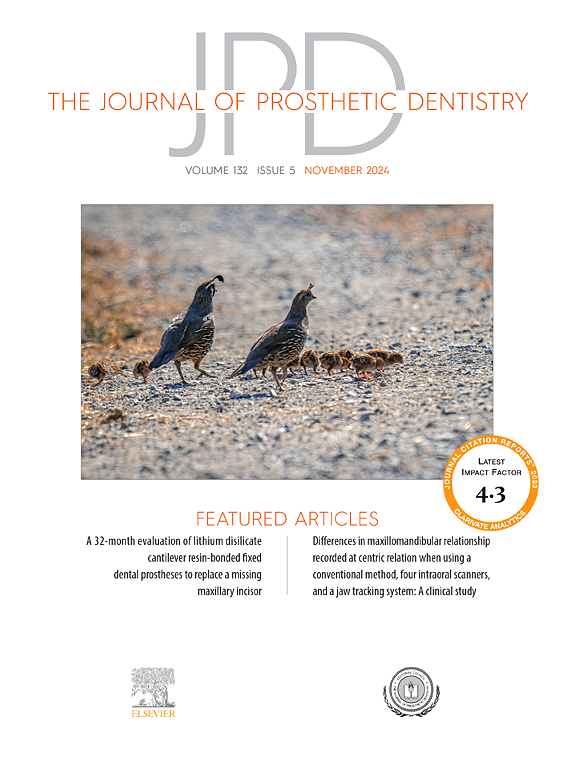Comparative effectiveness of fiber and metal posts in the restoration of endodontically treated teeth: A systematic review with network meta-analysis
IF 4.8
2区 医学
Q1 DENTISTRY, ORAL SURGERY & MEDICINE
引用次数: 0
Abstract
Statement of problem
Different varieties of fiber and metal intraradicular posts have been used for the restoration of endodontically treated teeth with insufficient sound tooth structure. Evidence on the comparative efficacy of posts in a clinical setting is insufficient to provide clear clinical guidelines and recommendations.
Purpose
The purpose of this systematic review with network meta-analysis was to assess the comparative efficacy of fiber and metal posts used for the restoration of endodontically treated teeth.
Material and methods
A search was conducted for trials published in Medline, Scopus, PubMed, and Cochrane Central Register of Controlled Trials from inception until November 2022. The study was registered with the International Prospective Register of Systematic Reviews (PROSPERO) (CRD42022384340). A network meta-analysis was performed on data from randomized controlled trials that assessed the comparative efficacy of fiber posts and metal posts for the restoration of endodontically treated teeth. Subgroup analyses were performed to compare all the varieties of fiber and metal posts. The types of posts were ranked according to their efficacy using the Surface Under the Cumulative Ranking (SUCRA) system. The Grading of Recommendations, Assessment, Development, and Evaluations (GRADE) approach was used to assess the level of certainty of evidence.
Results
Twenty-five articles were included in the quantitative analysis. Fiber posts (RR=0.15 [95% CI: 0.06, 0.33]) significantly prevented tooth fracture as compared with no posts. Prefabricated carbon fiber posts (RR=0.06 [95% CI: 0, 0.54]) ranked highest followed by custom glass fiber posts (RR=0.15 [95% CI: 0.04, 0.52]) and prefabricated glass fiber posts (RR=0.22 [95% CI: 0.07, 0.62]) in the outcome of tooth fracture. Metal posts (RR=0.24 [95% CI: 0.12, 0.46]) ranked higher than fiber posts (RR=0.39 [95% CI: 0.27, 0.56]) in the outcome of debonding. Custom gold alloy posts (RR=0.12 [95% CI: 0.03, 0.48]), prefabricated gold alloy posts (RR=0.04 [95% CI: 0.00, 0.87]), and prefabricated titanium posts (RR=0.21 [95% CI: 0.10, 0.45]) had higher rankings in the outcome of debonding or loss of retention of a post followed by custom glass fiber posts (RR=0.37 [95% CI: 0.21, 0.63]) and prefabricated glass fiber posts (RR=0.38 [95%CI: 0.25, 0.58]). Prefabricated glass fiber posts (RR=0.40 [95% CI: 0.20, 0.81]) had statistically significant differences in the outcome of secondary caries. The GRADE approach determined a moderate level of certainty of evidence.
Conclusions
The use of a fiber post when indicated results in reduced risk of tooth fracture as compared with no post. Prefabricated carbon fiber posts, prefabricated glass fiber posts, and custom glass fiber posts reveal a lower risk of tooth fracture. Overall, the use of prefabricated glass fiber posts had a lower risk of tooth fracture, debonding, and secondary caries. However, more trials with longer follow-up periods are recommended to enhance the certainty of evidence.
纤维桩和金属桩在根管治疗牙齿修复中的比较有效性:网络荟萃分析的系统综述。
问题陈述:不同种类的纤维和金属根内桩已用于修复根管治疗后牙齿结构不健全的牙齿。关于临床环境中各岗位的相对疗效的证据不足以提供明确的临床指南和建议。目的:本系统综述采用网络荟萃分析的目的是评估纤维桩和金属桩用于根管治疗牙齿修复的比较疗效。材料和方法:从开始到2022年11月,检索发表在Medline、Scopus、PubMed和Cochrane Central Register of Controlled trials上的试验。该研究已在国际前瞻性系统评价注册中心(PROSPERO)注册(CRD42022384340)。对随机对照试验的数据进行了网络荟萃分析,该试验评估了纤维桩和金属桩在牙髓治疗牙齿修复中的比较疗效。进行分组分析以比较所有种类的纤维和金属支柱。使用累积排名下的表面(SUCRA)系统根据帖子的功效对帖子类型进行排名。建议、评估、发展和评价分级(GRADE)方法用于评估证据的确定性水平。结果:25篇文章被纳入定量分析。纤维桩(RR=0.15[95%CI:0.06,0.33])与无桩相比可显著预防牙齿骨折。在牙齿骨折的结果中,预制碳纤维桩(RR=0.06[95%CI:00.54])排名最高,其次是定制玻璃纤维桩(RR=0.15[95%CI:0.042])和预制玻璃纤维柱(RR=0.22[95%CI=0.07,0.62])。在脱粘结果方面,金属桩(RR=0.24[95%CI:0.12,0.46])高于纤维桩(RR=0.039[95%CI:0.27,0.56])。定制金合金立柱(RR=0.12[95%CI:0.03,0.48])、预制金合金立柱,预制钛桩(RR=0.21[95%CI:0.10,0.45])在桩脱粘或固位损失方面的排名更高,其次是定制玻璃纤维桩(RR=0.037[95%CI=0.21,063])和预制玻璃纤维桩继发性龋齿。GRADE方法确定了中等程度的证据确定性。结论:与不使用纤维桩相比,在需要时使用纤维桩可降低牙齿骨折的风险。预制碳纤维桩、预制玻璃纤维桩和定制玻璃纤维桩显示牙齿骨折的风险较低。总的来说,使用预制玻璃纤维桩的牙齿骨折、脱胶和继发龋齿的风险较低。然而,建议进行更多随访期更长的试验,以提高证据的确定性。
本文章由计算机程序翻译,如有差异,请以英文原文为准。
求助全文
约1分钟内获得全文
求助全文
来源期刊

Journal of Prosthetic Dentistry
医学-牙科与口腔外科
CiteScore
7.00
自引率
13.00%
发文量
599
审稿时长
69 days
期刊介绍:
The Journal of Prosthetic Dentistry is the leading professional journal devoted exclusively to prosthetic and restorative dentistry. The Journal is the official publication for 24 leading U.S. international prosthodontic organizations. The monthly publication features timely, original peer-reviewed articles on the newest techniques, dental materials, and research findings. The Journal serves prosthodontists and dentists in advanced practice, and features color photos that illustrate many step-by-step procedures. The Journal of Prosthetic Dentistry is included in Index Medicus and CINAHL.
 求助内容:
求助内容: 应助结果提醒方式:
应助结果提醒方式:


